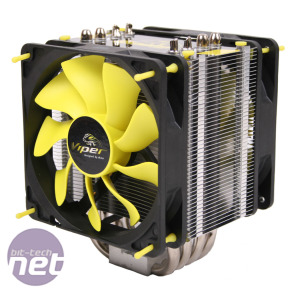
Results Analysis
While the Venom only ships with a single 120mm fan, Akasa provided a second Viper 120mm fan so we could test the Venom’s single- and dual-fan capabilities. First up was LGA1366 performance, where the Venom, like many other high end cooler’s we’ve recently reviewed, put in its best comparative performance. We saw a peak delta T of 51°C with one 120mm fan, and of 50°C with two - a minimal improvement considering the dramatically increased airflow and extra £16 or so of expenditure. While this is a great result, the Venom with one fan was only 1°C warmer than the Akasa Nero S which uses a much quieter fan, and 2°C off of the Titan Fenrir (at full fan speed) which is only a little louder than the noisy Venom and remains top of our cooling charts.LGA1156 performance for the Venom was also excellent, with a load delta T of 36°C with one fan and of 34°C with two. This is a slight improvement over the Nero S, which ran 1°C hotter than the Venom in one-fan configuration. However, the Fenrir is still the best cooler if you can handle a bit of extra noise, with a delta T of just 30°C.
Finally, the Venom was a disappointment on our AMD system, with a lowly delta T of 41°C with one fan attached and of 40°C with two. While the gap between the best aftermarket coolers and the AMD reference cooler isn’t as pronounced as with the Intel sockets, the significantly cheaper and quieter £26 Gelid Tranquillo managed a delta T of 38°C in the same system. The Fenrir managed a delta T of 37°C in quiet mode an of 35°C in noisy high-speed mode.
As the Venom’s included Viper fan defaults to 1,900rpm (albeit with a 4-pin PWM control), the cooler was fairly noisy, much noisier than the ear-friendly Nero S’s 1,200rpm fan. Adding a second Viper 120mm fan only added to the background drone - considering the fairly minimal performance improvements we saw when using two Viper fans and the extra £16 you’d spend to get that, we wouldn’t bother getting the second fan.


Click to enlarge - While the Venom ships with only one 120mm fan, adding a second had a minimal impact on performance
Conclusion
We were a little surprised when the Venom arrived on our desks, not least because Akasa had recently released a fine high-end, low-noise CPU cooler in the form of the Akasa Nero S. In comparison the Venom, which costs a couple of quid more than the £36 Nero S, offers very little extra performance. The performance increases that we did see can easily be explained by the increased airflow of the Viper fan (which spins at 1,900rpm rather than 1,200rpm), but this is far from being a quiet fan, unlike that of the Nero S.Also worthy of note is Akasa’s decision to include a sachet of OEM white thermal paste rather than more effective TIM. Good TIM can chop at least a couple of degrees off a CPU’s temperature, so we’re puzzled as to why Akasa (which makes and sells premium TIM) doesn’t include some with this high-end cooler.
As it stands, the Venom doesn’t overhaul the Titan Fenrir for all-out performance and isn’t much quieter. In fact, the Venom even struggles to make a case for itself versus Akasa’s own Nero S, as it’s much louder, not much better at cooling and the second fan mount is close to redundant according to our testing (with a fan supplied to us by Akasa for this purpose). This isn’t to say that the Venom is a poor cooler, it’s just that with the Nero S offering similar performance but less noise, and with the Fenrir offering better cooling for £8.61 less there are better alternatives for your cooling needs.
- Features
- x
- x
- x
- x
- x
- x
- x
- x
- x
- -
- 9/10
- Performance
- x
- x
- x
- x
- x
- x
- x
- x
- x
- -
- 9/10
- Ease of Use
- x
- x
- x
- x
- x
- x
- x
- -
- -
- -
- 7/10
- Value
- x
- x
- x
- x
- x
- x
- -
- -
- -
- -
- 6/10
- Overall
- x
- x
- x
- x
- x
- x
- x
- -
- -
- -
- 7/10

MSI MPG Velox 100R Chassis Review
October 14 2021 | 15:04








Want to comment? Please log in.